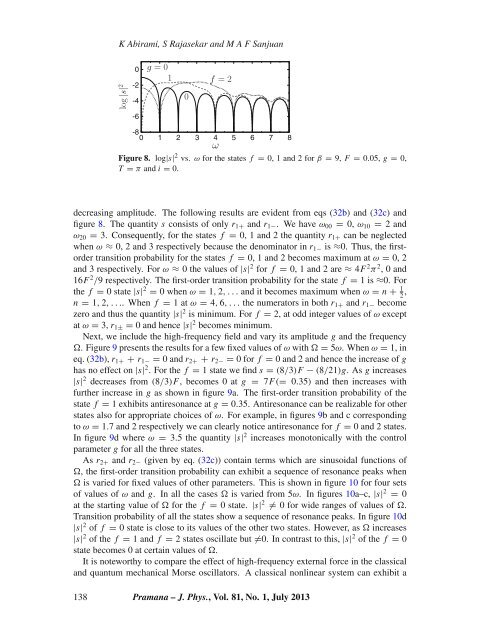Vibrational resonance in the Morse oscillator - Indian Academy of ...
Vibrational resonance in the Morse oscillator - Indian Academy of ...
Vibrational resonance in the Morse oscillator - Indian Academy of ...
Create successful ePaper yourself
Turn your PDF publications into a flip-book with our unique Google optimized e-Paper software.
K Abirami, S Rajasekar and M A F Sanjuan<br />
0<br />
-2<br />
-4<br />
-6<br />
-8<br />
0<br />
1<br />
2<br />
3<br />
4<br />
5<br />
6<br />
7<br />
8<br />
Figure 8. log|s| 2 vs. ω for <strong>the</strong> states f = 0, 1 and 2 for β = 9, F = 0.05, g = 0,<br />
T = π and i = 0.<br />
decreas<strong>in</strong>g amplitude. The follow<strong>in</strong>g results are evident from eqs (32b) and (32c) and<br />
figure 8. The quantity s consists <strong>of</strong> only r 1+ and r 1− . We have ω 00 = 0, ω 10 = 2 and<br />
ω 20 = 3. Consequently, for <strong>the</strong> states f = 0, 1 and 2 <strong>the</strong> quantity r 1+ can be neglected<br />
when ω ≈ 0, 2 and 3 respectively because <strong>the</strong> denom<strong>in</strong>ator <strong>in</strong> r 1− is ≈0. Thus, <strong>the</strong> firstorder<br />
transition probability for <strong>the</strong> states f = 0, 1 and 2 becomes maximum at ω = 0, 2<br />
and 3 respectively. For ω ≈ 0 <strong>the</strong> values <strong>of</strong> |s| 2 for f = 0, 1 and 2 are ≈ 4F 2 π 2 , 0 and<br />
16F 2 /9 respectively. The first-order transition probability for <strong>the</strong> state f = 1is≈0. For<br />
<strong>the</strong> f = 0 state |s| 2 = 0 when ω = 1, 2,...and it becomes maximum when ω = n + 1 2 ,<br />
n = 1, 2,.... When f = 1atω = 4, 6,...<strong>the</strong> numerators <strong>in</strong> both r 1+ and r 1− become<br />
zero and thus <strong>the</strong> quantity |s| 2 is m<strong>in</strong>imum. For f = 2, at odd <strong>in</strong>teger values <strong>of</strong> ω except<br />
at ω = 3, r 1± = 0 and hence |s| 2 becomes m<strong>in</strong>imum.<br />
Next, we <strong>in</strong>clude <strong>the</strong> high-frequency field and vary its amplitude g and <strong>the</strong> frequency<br />
. Figure 9 presents <strong>the</strong> results for a few fixed values <strong>of</strong> ω with = 5ω. When ω = 1, <strong>in</strong><br />
eq. (32b), r 1+ + r 1− = 0 and r 2+ + r 2− = 0for f = 0 and 2 and hence <strong>the</strong> <strong>in</strong>crease <strong>of</strong> g<br />
has no effect on |s| 2 .For<strong>the</strong> f = 1 state we f<strong>in</strong>d s = (8/3)F − (8/21)g. Asg <strong>in</strong>creases<br />
|s| 2 decreases from (8/3)F, becomes 0 at g = 7F(= 0.35) and <strong>the</strong>n <strong>in</strong>creases with<br />
fur<strong>the</strong>r <strong>in</strong>crease <strong>in</strong> g as shown <strong>in</strong> figure 9a. The first-order transition probability <strong>of</strong> <strong>the</strong><br />
state f = 1 exhibits anti<strong>resonance</strong> at g = 0.35. Anti<strong>resonance</strong> can be realizable for o<strong>the</strong>r<br />
states also for appropriate choices <strong>of</strong> ω. For example, <strong>in</strong> figures 9b and c correspond<strong>in</strong>g<br />
to ω = 1.7 and 2 respectively we can clearly notice anti<strong>resonance</strong> for f = 0 and 2 states.<br />
In figure 9d where ω = 3.5 <strong>the</strong> quantity |s| 2 <strong>in</strong>creases monotonically with <strong>the</strong> control<br />
parameter g for all <strong>the</strong> three states.<br />
As r 2+ and r 2− (given by eq. (32c)) conta<strong>in</strong> terms which are s<strong>in</strong>usoidal functions <strong>of</strong><br />
, <strong>the</strong> first-order transition probability can exhibit a sequence <strong>of</strong> <strong>resonance</strong> peaks when<br />
is varied for fixed values <strong>of</strong> o<strong>the</strong>r parameters. This is shown <strong>in</strong> figure 10 for four sets<br />
<strong>of</strong> values <strong>of</strong> ω and g. In all <strong>the</strong> cases is varied from 5ω. In figures 10a–c, |s| 2 = 0<br />
at <strong>the</strong> start<strong>in</strong>g value <strong>of</strong> for <strong>the</strong> f = 0 state. |s| 2 ̸= 0 for wide ranges <strong>of</strong> values <strong>of</strong> .<br />
Transition probability <strong>of</strong> all <strong>the</strong> states show a sequence <strong>of</strong> <strong>resonance</strong> peaks. In figure 10d<br />
|s| 2 <strong>of</strong> f = 0 state is close to its values <strong>of</strong> <strong>the</strong> o<strong>the</strong>r two states. However, as <strong>in</strong>creases<br />
|s| 2 <strong>of</strong> <strong>the</strong> f = 1 and f = 2 states oscillate but ̸=0. In contrast to this, |s| 2 <strong>of</strong> <strong>the</strong> f = 0<br />
state becomes 0 at certa<strong>in</strong> values <strong>of</strong> .<br />
It is noteworthy to compare <strong>the</strong> effect <strong>of</strong> high-frequency external force <strong>in</strong> <strong>the</strong> classical<br />
and quantum mechanical <strong>Morse</strong> <strong>oscillator</strong>s. A classical nonl<strong>in</strong>ear system can exhibit a<br />
138 Pramana – J. Phys., Vol. 81, No. 1, July 2013
















